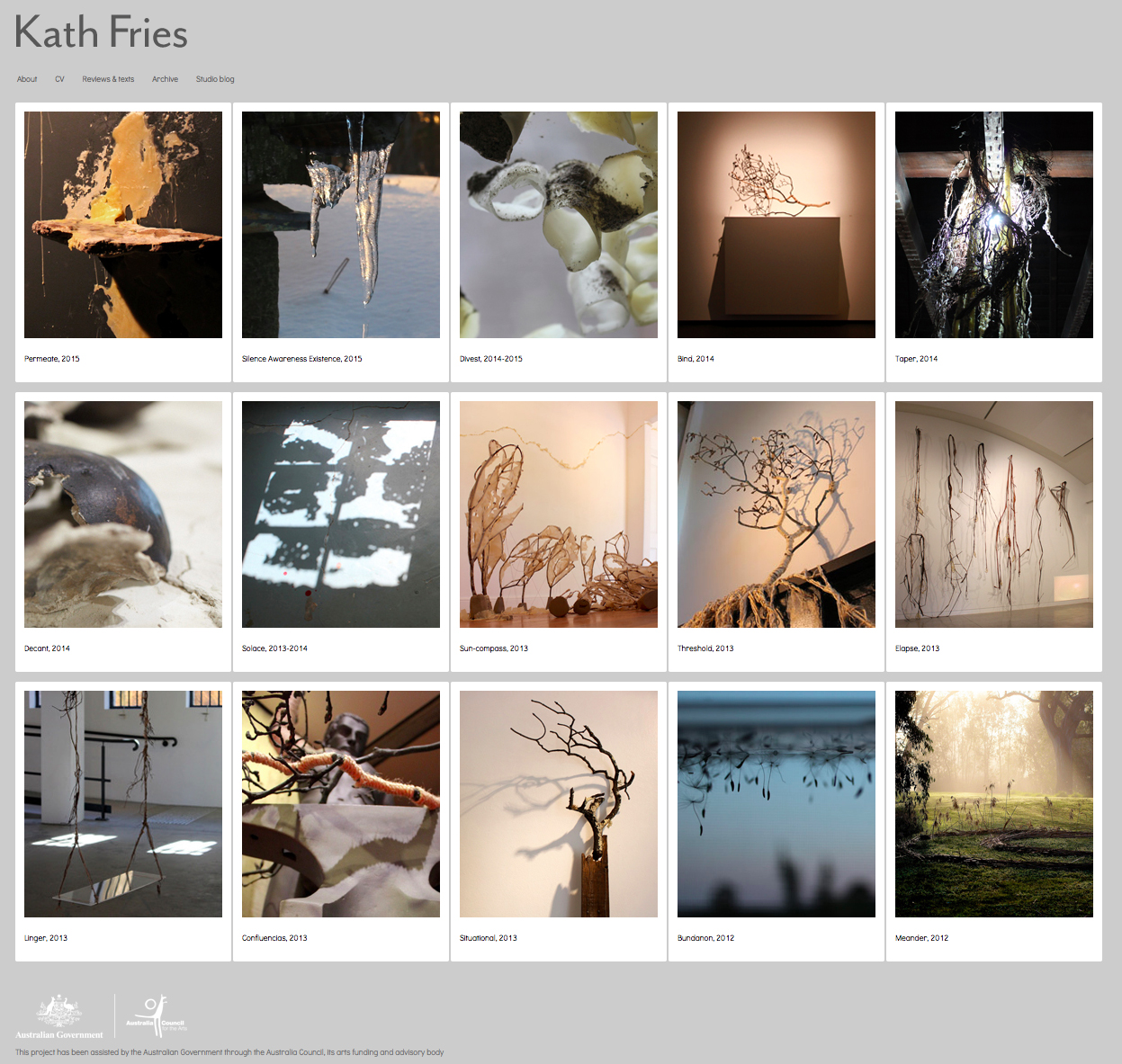A few months ago I was invited to propose a site-responsive installation using locally found natural materials, for the Making Ground exhibition at the Blue Mountains Cultural Centre Gallery. I began by looking around the Katoomba area and thinking about what materials I might use. As always, I was struck by the amazing mountain vistas - and noticed that these views were often framed by dangly stringybark hanging from incredibly tall eucalyptus trees.
 |
| Kath Fries, Elapse - work in progress, 2013, stringybark |
On closer examination I discovered that the ribbons of stringybark are surprisingly tough and robust, but also flexible with a strange sort of bendy elasticity, perhaps because the bark contains eucalyptus oil. Although stringybark trees grow all over Australia, the ones in the Blue Mountains are particularly tall, averaging 40m. These species include Blue Mountains Ash - Eucalyptus oreades, White Stringybark - Eucalyptus tenella, Peppermint Stringybark - Eucalyptus piperita, Brown or Blaxland's Stringybark - Eucalyptus blaxlandii, Messmate Stringybark – Eucalyptus obliqua. Extreme height, space, size, distance and endurance; seem to be recurring phenomena in the Blue Mountains.
 |
| Kath Fries, Blue Mountains Stingybark, 2013, photo |
At many of the lookouts around Katoomba, these tall trees and their stringybark frame the lengthening afternoon shadows and short trajectory of winter sunlight across the surrounding valleys and mountain ranges. Stringybark ribbons mark the passage of time, in a way like arms on a clock - but moving in a much slower cycle. When just a sapling, these trees begin to form bark as they grow upwards towards the sky. As the tree matures the bark becomes stringy and dangles down, eventually falling to the ground amongst the leaf-litter, waiting for a bushfire. The stringybark burns quickly fuelling the fire's heat that enables the eucalyptus gumnuts to burst and regenerate. Then then cycle begins again with a new tree growing from this seed.
 |
| Kath Fries, Blue Mountains Stingybark, 2013, photo |
Another natural material that I have been using increasingly in my artwork over the few months, is beeswax. Traditionally beeswax has been used to polish and preserve wooden objects and furniture, but contradictorily I've been experimenting with combining beeswax and stringybark to enhance the notion of fragility and continuous natural cycles. My melting, torn and crumbling layers of beeswax bring to mind recent alarming reports of increasing honeybee colony collapse disorders in Europe and America. The catastrophic implications of the European honeybee dying out around the world, seem almost apocalyptic. This issue was a key point in my recent installation Dwindle, (link to more info). Nature's finite ability to adapt to human impact is an issue I consider widely in my artwork, and our difficulties in managing bush fires is an underlying consideration in Elapse.
 |
| Kath Fries, Elapse - work in progress, 2013, stringybark and beeswax |
While still only in the early planning stages of this work, I had to give it a title for the exhibition catalogue. Challenging myself to choose one word that encompassed the passage of time and the gravitational movement of stringybark ribbons falling, I decided on Elapse - with its various meanings: to pass, intervene, lapse, pass by, slip away.
 |
| Kath Fries, Elapse - work in progress, 2013, stringybark and beeswax |
I always find the process of taking something natural and organic from the outside world into the sterile internal gallery space, to be an interesting exercise in re-focusing on materials and forms. Stringybark shapes seemed to have notable shift removed from a mass to just individuasl. None of the singular strands of stringybark I've collected hang perfectly straight - although outside on the trees they appear to. However, I love the shapes and textures of them, the contortions, bending and buckling. These facsinating shapes cast equally interesting shadows.
 |
| Kath Fries, Elapse - work in progress, 2013, stringybark silhouettes |
The Blue Mountians Cultural Centre Gallery has a ceiling hight of 7m - not as tall as the 40m trees outside, but an impressive vertical space for a gallery. The ribbons of stringybark I'm working with will reach almost floor to ceiling and give a sense of the massage size and age of the environment outside.
 |
| Kath Fries, Elapse - proposed installation, 2013, digital collage |
30 Parke Street, Katoomba, NSW
23 August - 6 October 2013
 |
| Making Ground, exhibition invitation |
Making Ground features the work of fourteen artists from the Blue Mountains and surrounds who use locally-found natural materials as a key element of their artistic process. The resulting work is diverse and serves as a visual reminder of the rich plant life and varied terrain occurring within the Greater Blue Mountains area. Artists: James Blackwell, Lexodious Dadd, Pam de Groot, Kath Fries, Michael Hoffman, Tony Lennon, Teekee Marloo, Scott Marr, Paula Martin, Brook Morgan, Simon Reece, Bill Samuels, Jacqueline Spedding and Chris Tobin. Curated by Rilka Oakley.





















%2BWhite%2C%2BBRANCH%2B3d.jpg)

















.jpg)













